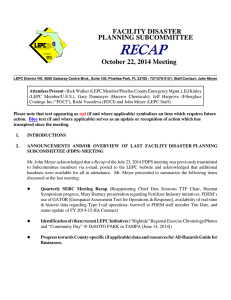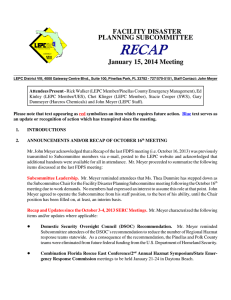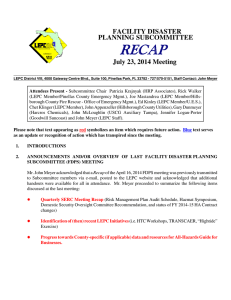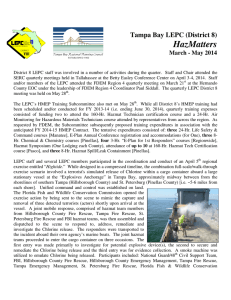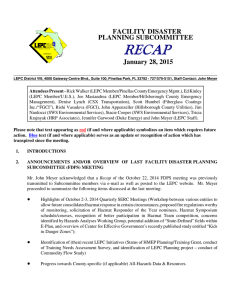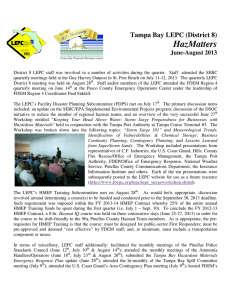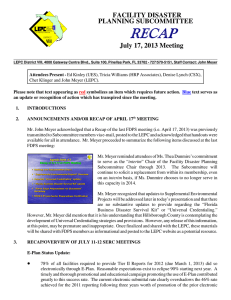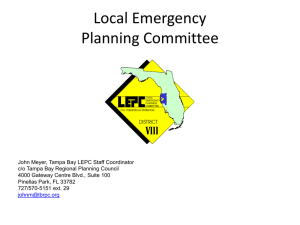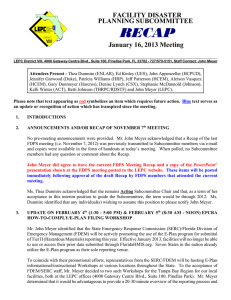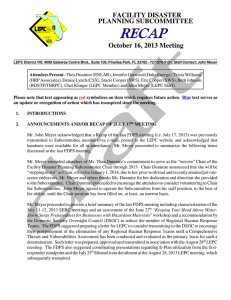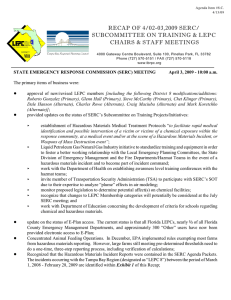RECAP FACILITY DISASTER PLANNING SUBCOMMITTEE
advertisement
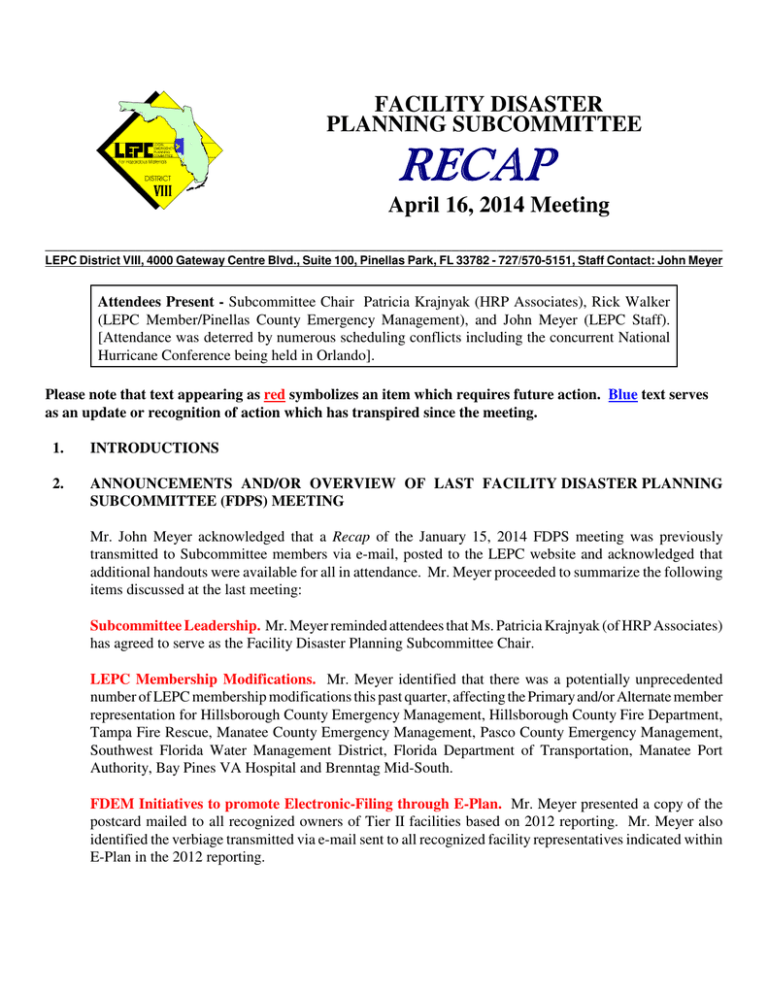
FACILITY DISASTER PLANNING SUBCOMMITTEE RECAP April 16, 2014 Meeting __________________________________________________________________________________________ LEPC District VIII, 4000 Gateway Centre Blvd., Suite 100, Pinellas Park, FL 33782 - 727/570-5151, Staff Contact: John Meyer Attendees Present - Subcommittee Chair Patricia Krajnyak (HRP Associates), Rick Walker (LEPC Member/Pinellas County Emergency Management), and John Meyer (LEPC Staff). [Attendance was deterred by numerous scheduling conflicts including the concurrent National Hurricane Conference being held in Orlando]. Please note that text appearing as red symbolizes an item which requires future action. Blue text serves as an update or recognition of action which has transpired since the meeting. 1. INTRODUCTIONS 2. ANNOUNCEMENTS AND/OR OVERVIEW OF LAST FACILITY DISASTER PLANNING SUBCOMMITTEE (FDPS) MEETING Mr. John Meyer acknowledged that a Recap of the January 15, 2014 FDPS meeting was previously transmitted to Subcommittee members via e-mail, posted to the LEPC website and acknowledged that additional handouts were available for all in attendance. Mr. Meyer proceeded to summarize the following items discussed at the last meeting: Subcommittee Leadership. Mr. Meyer reminded attendees that Ms. Patricia Krajnyak (of HRP Associates) has agreed to serve as the Facility Disaster Planning Subcommittee Chair. LEPC Membership Modifications. Mr. Meyer identified that there was a potentially unprecedented number of LEPC membership modifications this past quarter, affecting the Primary and/or Alternate member representation for Hillsborough County Emergency Management, Hillsborough County Fire Department, Tampa Fire Rescue, Manatee County Emergency Management, Pasco County Emergency Management, Southwest Florida Water Management District, Florida Department of Transportation, Manatee Port Authority, Bay Pines VA Hospital and Brenntag Mid-South. FDEM Initiatives to promote Electronic-Filing through E-Plan. Mr. Meyer presented a copy of the postcard mailed to all recognized owners of Tier II facilities based on 2012 reporting. Mr. Meyer also identified the verbiage transmitted via e-mail sent to all recognized facility representatives indicated within E-Plan in the 2012 reporting. “All Hazards Guide for Businesses.” Mr. Rick Walker, Pinellas County Emergency Management, had indicated that he and his Director, Ms. Sally Bishop, envisioned preparing and producing a handout for distribution to each of the facilities he visits annually while conducting Hazards Analyses in Pinellas County. The handout would be a listing of various resources and reference links to prepare Contingency Planning and Continuity of Operations (COOP) documents, Communications planning, encourage consideration of impacts potentially posed by neighboring facilities, identification of surge vulnerabilities... All present FDPS members had agreed that this would be a worthwhile initiative in which the Subcommittee could assist and that the county-specific resources could potentially be identified. 3. OVERVIEW OF APRIL 4, 2014 SERC MEETING Mr. Meyer identified the following as highlights to the April 4th SERC meeting: Risk Management Plan (RMP) Audits/Inspections Schedule. The 2014-15 schedule for the conduct of RMP audits/inspections and corresponding Plans review statewide was approved and released. Aside from three recent RMP audits conducted for Pinellas County facilities, three more audits are planned for facilities within or adjacent to Port Tampa Bay in May 2014, three for Plant City/Hillsborough County facilities in October 2014 and concluding with the audits of two Manatee County facilities in February 2015. RMPs are conducted at Section 302 facilities storing the most dangerous chemicals in pre-determined quantities/thresholds. It is the State’s intent to evaluate each of these sites a minimum of every five years with prioritization placed on new facilities or facilities recently changing ownership. Hazmat Symposium. The second annual Hazmat Symposium was held at the Ocean Center conference facility in Daytona Beach on January 23-24, 2014, in conjunction with the annual Fire Rescue East Conference and the State Emergency Response Commission quarterly meetings. This year’s event was viewed as a tremendous success with attendance more than doubling that recognized for last year’s inaugural event. Attendance was identified to be about 340. This year, three hazmat teams competed in the hazmat teams competition. Domestic Security Oversight Council (DSOC) Recommendation. John Koenke (Florida Fire College) identified that while the recommendation to reduce the number of regional hazmat response teams statewide was made official, pursuit of completion of Threats and Vulnerabilities study continues. Mr. Koenke added that while the issue had been determined in a close vote, the DSOC board membership is due to change in the near future. Having a completed and thorough Study in hand could serve as reasonable grounds for reconsideration of the prior proposed reduction in hazmat teams. Hazards Analyses Contracts. Hazards Analyses are required for 50 percent of all Section 302 facilities within each County annually. In other words, Hazards Analyses are conducted for every Section 302 facility biennially. Up until this point, the Contracts and work products were coordinated through the Florida Division of Emergency Management. Unfortunately, the FDEM is left with 2-3 people evaluating all work products throughout the State. The LEPCs recently proposed administering the HA Contracts and evaluating the corresponding work products as a means of reducing FDEM’s work load. The SERC approved the transference of these responsibilities to the LEPC starting with the FY 2014-15 Contract year. Necessary 2 components of the agreement include the LEPCs providing localized training for the personnel conducting the HAs as well as to those reviewing the work products. Tampa Bay LEPC’s HMEP Training Subcommittee Chair James Johnston proposed that representatives from the various Counties could serve in the review capacity for an adjacent County (e.g. Pasco County could review Hillsborough County’s deliverables...). 4. RECENT LEPC INITIATIVES Mr. Meyer characterized the following recent activities undertaken by LEPC staff: How-to-Comply Workshops. Conducted and hosted the How-to-Comply & E-Plan Filing Workshops on February 11 & 12, 2014 at the LEPC/TBRPC offices. A total of 23 attended the training over the two-day period. The Florida Division of Emergency Management subsequently indicated that E-Plan utilization rate for filing of Tier II reports exceeded 90 percent for the 2013 reporting year. TRANSCAER Workshops. Transportation Community Awareness and Emergency Response training was provided at the CSX/TRANSFLO facility in Tampa on February 18 & 19, 2014. LEPC staff participated with the coordination and registration of this event. Each of the 5+ hour workshops focused on Chlorine, Ammonia or Ethanol and each included a Railcar Safety 101 component. The courses were well-received and a recommendation was formulated to reduce the course lengths, if possible, to allow an attendee to participate in more than one educational theme per day. A total of 160 benefitted from the training over the two-days. Regional Exercise. LEPC staff partcipated in the development and conduct of the Hightide exercise conducted on April 5, 2014. The scenario involved the response to a simulated Chlorine release aboard an anchored terrorist vessel in Tampa Bay, essentially midway between Hillsborough and Pinellas County. The exercise involved the joint and unified response of the Tampa, Hillsborough County and St. Petersburg hazmat teams. The exercise was deemed a tremendous success by all involved. 5. COUNTY-SPECIFIC “ALL HAZARDS GUIDE FOR BUSINESSES.” At the January 16th meeting, it was proposed that the FDPS develop an electronic database of resources and links to assist businesses with developing planning initiatives to address the concepts of Contingency Planning, Continuity of Operations and Disaster Recovery associated with a variety of hazards: Hurricanes, Tornados, Thunderstorms/Lightning, Fires, Floods, Hazardous Materials, Terrorism/Violence in Workplace, Cyberterrorism and Civil Disorder. Definitions and pictures of these hazards have been obtained from a variety of sources. The remaining and most important task will be to research and identify data sources and links for businesses to utilize when refining their business disaster plans to address these hazards. Recommendations are expected to include: resource supply chain information, mutually-beneficial pre-coordination between facilities & government in order to establish prioritization; need for facilities to notify their suppliers of closed transportation networks so alternate routes can be determined; potential risk posed by adjacent (or nearby) Section 302 facilities; and need to address temporary housing for employees. 3 The following constitutes the work product at this point: 4 6. OTHER ISSUES/COMMENTS. No other issues or comments were identified by Subcommittee members. 7. ADJOURNMENT Mr. Meyer informed attendees that the next FDPS meeting date needs to be rescheduled from July 16th to July 23rd on account of the unexpected changing of dates associated with the next State Emergency Response Commission quarterly meeting. The meeting was adjourned at 12:50 p.m. 5
